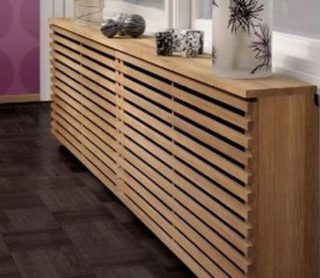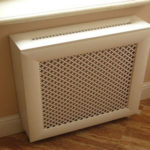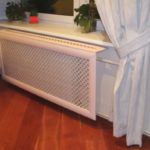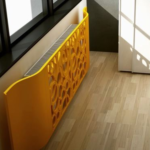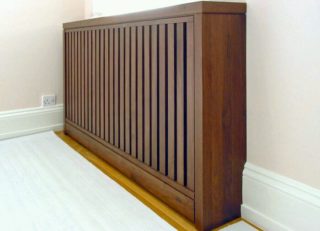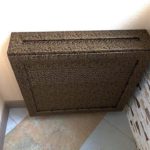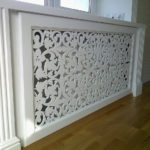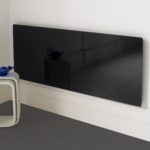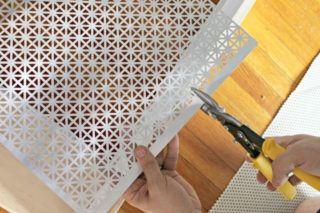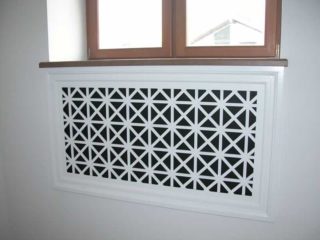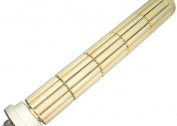Radiators are an important element in home improvement. To combine them with the interior of the room, you can install a decorative screen on them. On sale there are lattices of different colors, shapes and styles, but if you wish, you can make a screen yourself. To do this, there are instructions with a step-by-step description of creating a protective and decorative shield for a heating device.
Lattice Functions
The screen on the battery performs several important functions. These include:
- Masking the battery in order to transform the room and preserve a single stylistic composition.
- Dust protection. The grille is easier to clean, and its availability extends the life of the radiator.
- Protection against accidental contact with hot or protruding parts of the radiator.
- When creating the right design, the flow of warm air will be distributed more evenly throughout the room.
- The top cover can be opened and also used as a shelf for installing interior trifles.
- On the grill you can make a hook for drying clothes.
In the presence of imagination, little experience and with a wide selection of materials, you can independently create a screen that suits the style and will perform all the necessary functions.
Using a protective grill will slightly reduce the efficiency of the heating system. To avoid this, you need to choose the right structure of the future product and materials. The use of a foil surface behind the battery also helps - it reflects heat and directs it inside the room.
Varieties of screens
Classification of grilles for heating radiators is possible by the installation method. There are three types of screens:
- Curbstone. It is a box with a lid. Used to completely hide the battery.
- Flat panel. Suitable for use on radiators installed in a niche or under a window sill.
- Hinged panel. It is used in case of a protrusion of the battery from under the windowsill.
- Stand
- Hinged panel
- Flat panel
The following materials are used to create a protective and decorative lattice:
- wood;
- different types of metals;
- plastic;
- glass;
- Particleboard, MDF and other types of plywood.
A metal shield is a good conductor of heat. It is more difficult to do, since you need special equipment, as well as skills to work with the tool. From a metal sheet, you can create a lattice that has a sophisticated unique look, with complex geometric shapes and swirls. Parts are joined by welding.
Wooden models are environmentally friendly and safe. The material is easy to work out. But you need to be able to choose the right tree, as well as work it out with special tools. Otherwise, the wood is prone to deformation and drying out under the influence of humidity and hot air. Suitable for installation in eco-style rooms.
Plastic is an inexpensive and affordable material with a wide range of colors. Of the disadvantages distinguish deformation at high temperature and the release of harmful substances. Not suitable for permanent installation in rooms where people live.
Glass models belong to the class of elite products, therefore they are expensive. They can be equipped with LED lighting, decorate with drawings. Do-it-yourself screen on the battery is made of durable tempered glass.
- MDF
- Metal
- Plastic
- Glass
The most common are screens from MDF panels.They practically do not differ from wood in their quality, easy to care and work. They have a rich color palette and a wide selection of textures and styles.
Atypical materials are less commonly used: fabric, bamboo, thick cardboard.
Self-made box
The shield completely closing the heater is one of the most popular models among home masters. It can be made from a wide variety of materials and with different options.
First of all, it is necessary to prepare:
- MDF or chipboard panels in a suitable color;
- metal mesh;
- rear reflector made of metal or foil;
- fasteners;
- hacksaw;
- drill;
- glue;
- sand paper.
The box is a case without a back wall. The front and end parts are made of metal mesh, which is enclosed in a decorative frame. This is a stylish option that does not interfere with the heat transfer of the radiator. The lid can be made of mesh or solid canvas.
Sketch creation
Work begins with measuring the battery and creating a sketch and drawings of the future shield. It is necessary to measure the length and width of the radiator. For a box, these values are increased by 5 cm for height and 10 cm for width. You must also measure the depth of the battery and add 2.5 cm to the grill. The dimensions of the cover will be equal to the width of the front panel, plus 1-2 cm.
Next, the resulting patterns need to be redrawn on a metal mesh and cut to size. One element is needed for the facade, two for the ends and one for the cover. Also on the side parts you need to provide places for the output of the heating system.
Elements are cut out from the plates for the design of the lattice. In the case of an integral cover, it also needs to be cut from MDF. The ends of the resulting rails are cut off at an angle of 45 °, so that later it would be more convenient to connect the frame. Saws are sanded with sandpaper.
Assembly parts
After preparing all the parts, you can assemble the grill. Four rails must be fixed to each other with glue and nails. End parts and cover are connected in the same way. On the reverse side, a metal mesh is attached to the stapler.
Next, the finished panels are connected to each other. When the assembly is finished, you can decorate the box.
Battery Mount
Previously, the wall behind the heating device must be pasted over with heat-reflecting material. Its dimensions may equal the dimensions of the battery or be slightly smaller.
Box can be put in several ways:
- To the legs. They are fixed to the bottom of the grill. It is advisable to choose furniture legs with the ability to adjust the height.
- Dowels with hooks. With their help, the box will be suspended. To do this, make holes in the wall for hooks, insert them and fix the grate.
- Anchors with bolts. They are driven into a predetermined place and the bolts are tightened. A box is mounted on them.
The choice of installation method depends on the convenience. He does not affect the functionality of the screen for a radiator with his own hands.
Decorative grill
Not in all cases, it is advantageous to use the design in the form of a box. You can do with a screen in the form of a front panel with perforation. It will fit the size of the radiator that is hiding.
The grid is made of metal mesh, MDF panels. The operation algorithm is similar to the steps for creating a box. If you have experience and skills, you can make a shield in the form of a wooden rack structure by the type of blinds. Then the slats will be placed in any direction: vertical, horizontal, diagonal. If you wish, you can make a screen for the radiator with your own hands from cells, but such a structure will be more complicated, since all the elements need to be placed at right angles.
Tips for home craftsmen
It is important to create or buy such a screen so that it does not violate the main function of the radiator - heating the room. It should not be an obstacle and greatly reduce effectiveness. There will be losses, but they can be minimized.To do this, make nets with a large number of holes that do not interfere with the circulation of air masses.
To improve efficiency, you can combine different materials. Metal and wood, metal and MDF panels will allow you to make an improved box for a heating battery with your own hands.
When choosing a model or making your own grill, it is important to consider the possibility of cleaning. An accident can also occur, so the shield must be easily removable to access damaged areas.
